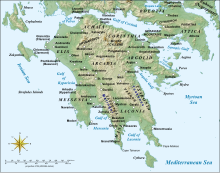Barony of Patras
| Barony of Patras | |||||||
|---|---|---|---|---|---|---|---|
| Barony of the Principality of Achaea | |||||||
| 1209–1429/30 | |||||||
 Map of the Peloponnese with its principal locations during the late Middle Ages | |||||||
| Capital | Patras | ||||||
| Area | |||||||
| • Coordinates | 38°15′N 21°44′E / 38.250°N 21.733°E | ||||||
| • Type | Feudal lordship | ||||||
| Historical era | Byzantine reconquest | 1429/30 | |||||
| |||||||
The Barony of Patras was a medieval
History
The Barony of Patras was established ca. 1209, after the conquest of the
According to the French, Greek and Italian versions of the Chronicle of the Morea, the secular barony was granted to a knight from the Provence, William Aleman, but the Treaty of Sapienza between Achaea and the Republic of Venice, concluded in June 1209, mentions Arnulf Aleman as baron, probably William's otherwise unknown predecessor. In addition, the Aragonese version of the Chronicle lists a completely different, but unverifiable series of barons, beginning with Walter Aleman, who was succeeded by his son Conrad and he in turn by William (II), who then sold the rights to the barony to the Archbishop of Patras ca. 1276.[6] Historians have generally followed this account in dating the cession of the barony to the Archbishopric to about or shortly after the middle of the century, but the transfer may have taken place, or at least begun, as early as the 1220s, for the first archbishop, Antelm of Cluny, is said to have had possession of the Patras Castle by 1233.[7]
The Archbishop now found himself, with thirty-two fiefs, as the strongest vassal of the Principality, and became a major factor in its affairs. Under
For the remainder of the century, the Archbishops of Patras played an active role in the intrigues and feuds of the Principality, and in turn the contending families often tried to place one of their own scions on the archiepiscopal throne.
References
- ^ Miller 1921, pp. 71–72.
- ^ Bon 1969, pp. 106, 450.
- ^ Miller 1921, p. 72.
- ^ Bon 1969, p. 450.
- ^ Miller 1921, p. 78.
- ^ Bon 1969, pp. 106–107, 450.
- ^ Schabel 2008, pp. 121–122.
- ^ Bon 1969, pp. 450–451.
- ^ Topping 1975a, p. 118.
- ^ a b Bon 1969, p. 451.
- ^ Topping 1975a, pp. 124–125.
- ^ Bon 1969, pp. 451–452.
- ^ Topping 1975b, pp. 161–162.
- ^ Bon 1969, p. 452.
- ^ Topping 1975b, p. 165.
Sources
- Bon, Antoine (1969). La Morée franque. Recherches historiques, topographiques et archéologiques sur la principauté d'Achaïe [The Frankish Morea. Historical, Topographic and Archaeological Studies on the Principality of Achaea] (in French). Paris: De Boccard. OCLC 869621129.
- OCLC 457893641.
- Schabel, Chris (2008). "Antelm the Nasty, First Latin Archbishop of Patras". In Beihammer, Alexander D.; Parani, Maria G.; Schabel, Christopher D. (eds.). Diplomatics in the Eastern Mediterranean 1000–1500: Aspects of Cross-Cultural Communication. Leiden: BRILL. pp. 93–138. ISBN 978-90-04-16547-2.
- Topping, Peter (1975). "The Morea, 1311–1364". In ISBN 0-299-06670-3.
- Topping, Peter (1975). "The Morea, 1364–1460". In ISBN 0-299-06670-3.
